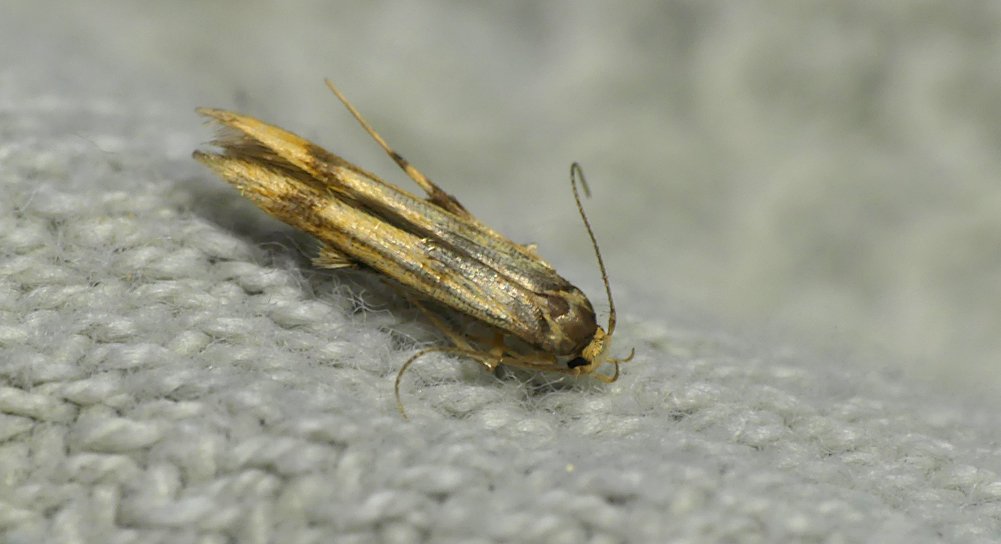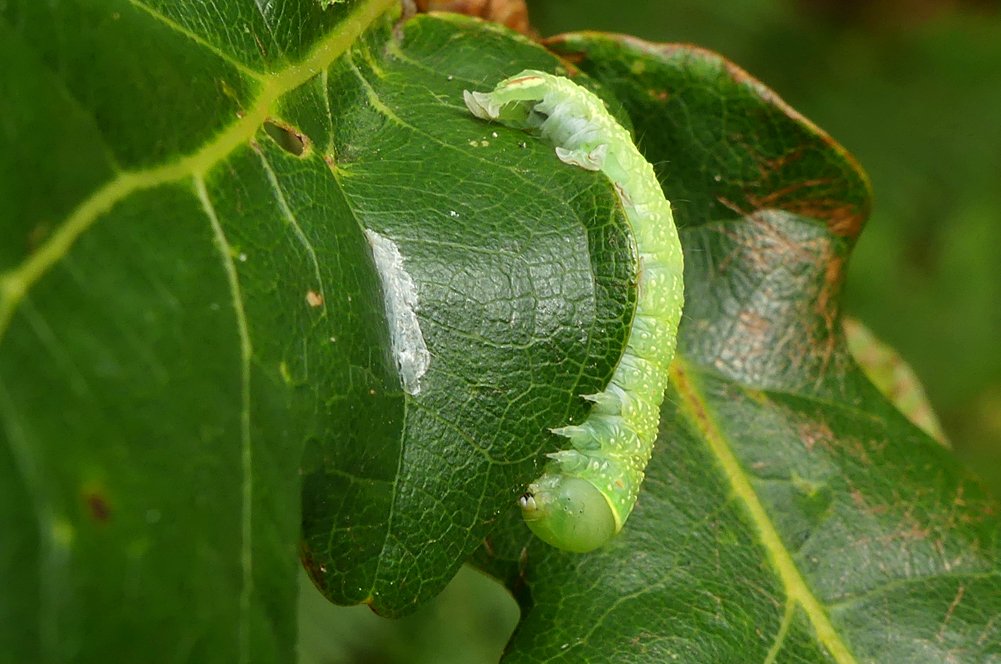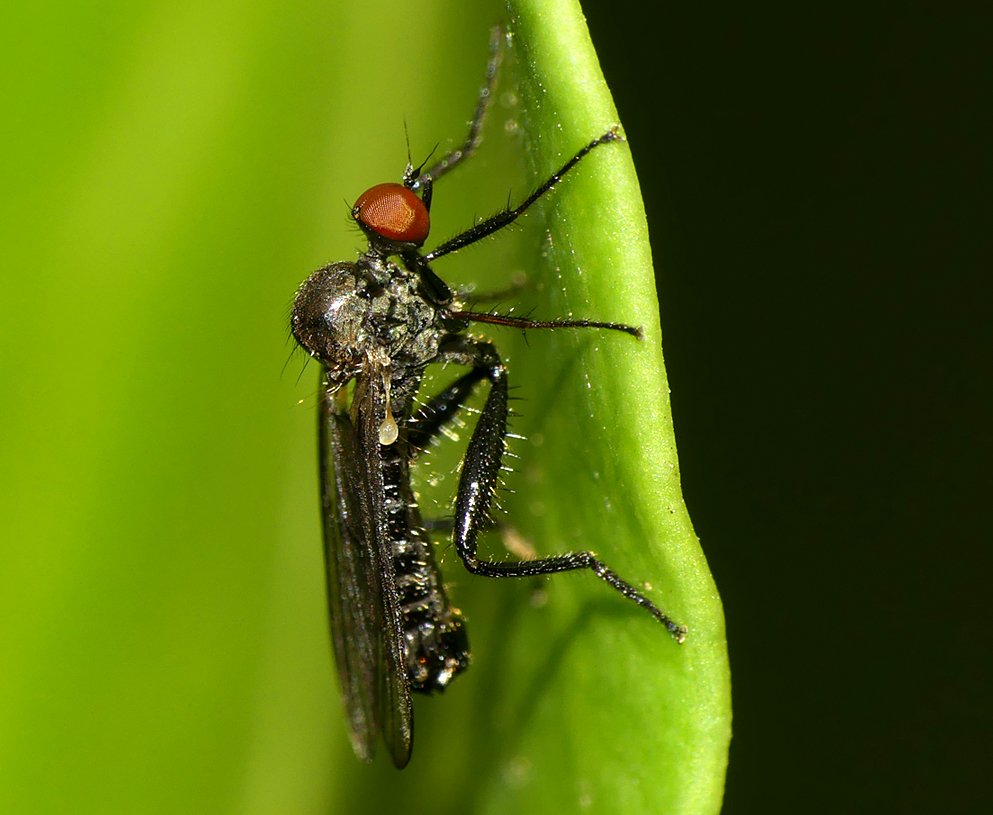July 2022
/When I popped to L’Ancresse after work on 5th July to see a rare plant I was certainly not expecting to find a new moth for the British Isles*! I had noticed on the local Botanists facebook group that they had posted about the very rare Fringed Rupturewort, and where it could be found on Guernsey. I had never noticed this very inconspicuous, low-growing plant before so I thought that I’d have a quick look before heading back home. I found the plants quite easily as they were one of the few species on the edge of the golf course which hadn’t been totally scorched by the dry weather and were still quite green. After taking a few snaps on the phone, I noticed a tiny movement, which I thought was an ant carrying a bit of detritus.
When I got down low and put my glasses on I was surprised to see that it was a Coleophora case. (This genus of moths make a case out of plant materials which they carry round for protection). These are usually very plant specific and so I thought it might be very interesting due to the rarity of this plant which only grows in one place in mainland UK. Looking round the area, I noticed that there were lots and lots of these cases and the moth was clearly quite common here. I took a few photos and collected a few in a pot to look at later and headed home.
Coleophora cases on Fringed Rupturewort - L’Ancresse, 5 Jul 22
Back at home I looked through the books I had about Coleophora moths but there was nothing at all about any species which lives on Fringed Rupturewort. I put out a photo on twitter with a request for help, but there was no response at all. In the meantime, I was googling and finding it very difficult to find anything until I came across a Swedish website with photos of Coleophora cases on Smooth Rupturewort (a similar species in the same genus). This species was Coleophora scabrida and the photos of the cases was more or less identical to the specimens I had in front of me.
I took some better photos and was contacted by a micro-moth expert that I had tagged onto the twitter photo, who seemed to feel that these moth larvae were very likely to be scabrida as I suspected. I returned back to the site a week or so later and collected a few more specimens and mailed them off to him, and he was planning to send some off to the Natural History Museum for analysis. Coleophora scabrida has not been recorded in Britain before as far as I know, so this would be a new species for the Channel Islands and also the British Isles (*depending on your definition of what that is!).
Fringed Rupturewort is so rare in the UK that it is not a surprise it has not been found on that plant, but Smooth Rupturewort is more widespread and one might have thought it would have been found on that species if it lived in the UK. There are many species that live in the Channel Islands but not the UK, but I wonder if this is a new arrival, or if it has been here a long time undetected. This record is not fully confirmed yet and so this may all be premature, but the likelihood is pretty high. We shall wait and see.
Coleophora scabrida - L’Ancresse, 5 Jul 22
Coleophora scabrida - L’Ancresse, 5 Jul 22 - a random photo of the plant showing the density of the cases present.
As well as the exciting discovery above, July 2022 was a superb month for moths overall, probably mainly due to the ridiculously high temperatures during the month. There were a few days which reached the late 30s degrees and so the nights were so warm. The first two weekends were quite average with Splendid Brocade being the best moth in that time. On 11th July, it was my annual “bring-the-trap-to-work” day to show the year 7s and, as usual, it coincided with a good catch, the kind of catch where I’d much prefer to go through it in detail at home rather than surrounded by 12 year-olds in the school car park.
There were three new species for the garden inside the trap which I managed to pot up before they were scared away by children. There was a wave which looked slightly different - a bit creamy with buff cross-lines - which I eventually worked out was Lesser Cream Wave, very rare in Guernsey. Also, there was the “pyralid” moth Hypsopygia glaucinalis which I have only seen once before, at someone else’s trap here in Guernsey many years ago - probably a migrant here. The third was Stathmopoda pedella which I recognised straight away because the first for Guernsey was posted up just a few days before. Three new garden moths in one catch - can’t remember when that happened last.
Lesser Cream Wave - garden, 11 Jul 22
H glaucinalis - garden, 11 Jul 22
Stathmopoda pedella - garden, 11 Jul 22
As it was so good the previous night, and because I had a late start due to a school trip to Herm, I put out the trap again mid-week on 12th July, and I was pleased that I did. Wax Moth and Corn-borer were joined by a Scorched Carpet - new for me and rare for Guernsey. The larva fee don Spindle, which is not a shrub which occurs in Guernsey (although I am sure it exists in some gardens) so this was likely an immigrant.
Scorched Carpet - garden, 12 Jul 22
The next weekend was a nice early start to the summer holidays and so I could trap whenever it looked good. On 17th I had another new species for the garden - Bucculatrix thoracella. This species has only recently arrived in Guernsey and feeds on Lime - we have a lime tree overlooking the garden so it was not a surprise to have another five during the next week or so.
Bucculatrix thoracella - garden, 15 Jul 22
The couple of days around 17th and 18th were the hottest days of all and both nights I had 120+ species in the trap - not as many really rare stuff but lots of things I rarely see. On 17th July, I had another Stathmopoda pedella and a Cydia medicaginis, a tortrix which I had new for Guernsey a couple of years ago. On 18th there was a better selection including the third Stathmopoda pedella as well as some rarer species for me like Bright Wave, Lunar Thorn, Small Rivulet, Olive and G. janthinana. The best one was a tiny, dark moth of the family Heliozidae - no species from this family has ever been recorded in Guernsey before. Unfortunately subsequent investigations were unable to identify this to species - it was a female and either Heliozela hammoniella or Heliozela resplendella.
Heliozela sp. - Garden, 18 Jul 22
Thereafter, temperatures dropped a little and things were quiet but a final flourish on 21st July was a Dotted Rustic - a new macro-moth for Guernsey! A not-so-distinctive but actually quite-distinctive species to identify.
Dotted Rustic - garden, 21 Jul 22
Another target that I wanted this year was to take some photos of Purple Hairstreak, which I have never done before. These are not rare in Guernsey but I rarely see them, and when I do they are generally fluttering at the top of oak trees. This year seems to have been pretty good for them and people had been seeing them well at La Garenne around the isolated oaks. So I stopped on the way home from work and managed some pleasing shots.
Purple Hairstreak - Garenne, 4 Jul 22
Purple Hairstreak - Garenne, 4 Jul 22
Purple Hairstreak - Garenne, 4 Jul 22
Carrying on the lepidoptera theme, armed with my new caterpillar field guide I was keen to search for some larvae this year and was moderately successful. It is hard to find them without beating or sweeping however.
Grey Pug larva - Les Vardes, 9 Jul 22
Poplar Grey larva - Grande Mare, 20 Jul 22
Green Silver-lines - Les Sommeileuses, 27 Jul 22
Green Silver-lines - Les Sommeileuses, 27 Jul 22
Green Silver-lines - Les Sommeileuses, 27 Jul 22
Stigmella sp. - Les SomMEILEUSES, 27 Jul 22
Dioryctria sylvestrella - garden, 15 Jul 22
Bird-wise, there was nothing rare to see and even the heat didn’t push anything unusual in from the south (I was hoping for small flocks of Egyptian Vultures crossing the sea). The Balearic Shearwaters were present in four-figure flocks off Pleinmont as they have been most years now. By the end of the month there was the odd returning wader with two Common Sandpipers at Fort le Marchant on 22nd and the first Whimbrel at Pulias on 31st.
shearwater flock - Pleinmont, 9 Jul 22 - each pale speckle is one shearwater
Black-headed Gull - Perelle, 11 Jul 22
Of course, I managed a few insect-hunting sessions and found quite a few new species for me. One of my favourites being the tiny wasp below - Brachygaster minutus with its tiny waist tucking its abdomen into its body and how it holds its wings almost vertically.
Brachygaster minutus - Les Vardes, 9 Jul 22
Colletes fodiens - Les Vardes, 9 Jul 22 - is there a more photogenic species of insect?
male Pantaloon Bee - Grande Mare, 20 Jul 22
Gronops lunatus - L'Ancresse, 5 Jul 22
Hybos culiciformis - Les SomMEILEUSES, 27 Jul 22
Throatwort - ST. Peter Port, 13 Jul 22
Throatwort is a well-established alien which thrives on St. Peter Port walls. A Hummingbird Hawk-moth was feeding on this as I walked past.




























